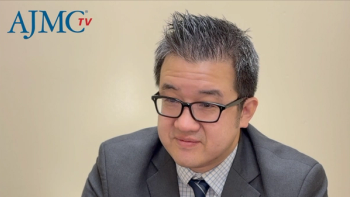
Phase 1 Trials Assess Safety, Dosing of CAL-R Antibody for Essential Thrombocythemia: John Mascarenhas, MD
John Mascarenhas, MD, discusses the rationale, mechanism, and design of the phase 1 INCA33989-101 and -102 trials investigating a CAL-R–targeted antibody for patients with essential thrombocythemia.
In part 1 of an interview conducted after the
He presented these data, as summarized in the
This transcript was lightly edited; captions were auto-generated.
Transcript
To start, could you describe what INCA33989 is and how it works?
[INCA33]989 is an antibody specifically and selectively directed towards the mutant CAL-R [calreticulin] protein that's expressed on the surface of hematopoietic stem progenitor cells and myeloid-derived lineage cells in combination with the thrombopoietin receptor. It's a very, I think, clever and simple way of tagging those cells selectively.
What's really interesting about the antibody is [that] it's a humanized antibody. It lacks an Fc-engaging portion, so it actually does not engage the immune system. What it does is it binds to the complex of the thrombopoietin receptor and the mutant CAL-R protein, which is expressed on the surface of the cells. It internalizes that complex and turns off the aberrant JAK/STAT signaling pathway that maintains the cell viability and survival, thereby inducing apoptosis in preclinical models.
It really looks like a really selective and clean immunotherapeutic approach to treating CAL-R-mutant
Why is targeting mutant CAL-R considered a promising approach for treating essential thrombocythemia (ET)?
Myeloproliferative neoplasms are hematopoietic stem cell–derived clonal hematologic malignancies that are chronic but progressive. They have a lot of symptom burden, a lot of morbidity, and can progress to myelofibrosis [MF], or acute myeloid leukemia, and can limit life.
There are 3 main driver mutations: JAK2 V617F, about 50 to 60% of patients with ET, essential thrombocythemia, and primary myelofibrosis. Then, about 25% to 30% of patients have a mutant CAL-R driver mutation, both in ET and myelofibrosis. Then, there's about 5% of patients who have an MPL, which is a thrombopoietin receptor mutation.
There are 10% of patients who are triple negative. Those patients tend to do very poorly, and there's probably alternative mechanisms that activate the JAK/STAT signaling pathway, which is the central theme among these driver mutations.
But the mutant CAL-R is very interesting because, unlike JAK2 V617F, which is a tyrosine kinase that's mutated inside the cell, the mutant CAL-R is actually expressed on the surface of the cell in combination with the thrombopoietin receptors. That aberrant complex signals through JAK/STAT, which causes the phenomenon of the overproduction of platelets, cytokines, inflammation, symptoms, splenomegaly, fibrosis, and progressive disease.
Knowing that information, which, obviously, [it] took many years to get that far. So, 2013 is when mutant CAL-R was first identified by Jyoti Nangalia, MBBS, PhD. There's been a successive number of studies that have delineated the mechanism [by] which mutant CAL-R induces hyperactive JAK-STAT signaling, and then identifying that it's aberrantly expressed on the surface of the cells, and then developing therapies.
Incyte was really at the forefront of developing [INCA33]989, which is this antibody to mutant CAL-R, with the hopes that we could more selectively target the disease at the highest level, at the mutant CAL-R protein-expressing malignant cells.
With that in mind, can you describe the primary objectives of the phase 1 INCA33989-101 and -102 studies? What methods were used to evaluate the treatment?
I think this is one of the most elegant translational studies that we've seen in a long time, where the preclinical modeling informed that this antibody, [INCA33]989, would induce apoptosis and potentially transform the disease process in culture and in animal models.
With any first-in-human phase 1 study, we had to first test the drug in a dose escalation [and] dose finding study, which is what [INCA33989-]101 and [INCA33989-]102 were. [INCA33989-]101 and [INCA33989-]102 really just signified the fact that there were 2 trials being run at the same time. [INCA33989-]101 was outside the US, so basically Asia and Europe, and then [INCA33989-]102 was the US.
The 2 trials were running simultaneously. We started at low doses, 24 mg of this antibody in cohorts of 3. Then, [the] dose escalated all the way up to 2500 mg. Dose escalation [was used] to try to identify any dose-limiting toxicities, to identify the maximally tolerated dose, [and] ultimately the recommended phase 2 dose.
What's really, I think, fun about this study is it was evaluating the drug in [patients with] ET, which is what we're going to discuss today, but there's also a study going on that we'll present probably at ASH [American Society of Hematology Annual Meeting], evaluating the drug in [patients with] MF, both as a monotherapy [and] in combination with ruxolitinib.
You can see the application of this agent across mutant CAL-R disease types. It's not specific for one subtype, or at this point, one subtype of MPN. To me, that's really exciting. It's really a molecularly driven therapeutic with an immune-based approach.
Newsletter
Stay ahead of policy, cost, and value—subscribe to AJMC for expert insights at the intersection of clinical care and health economics.












































